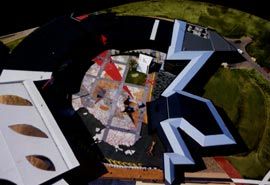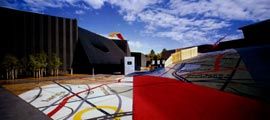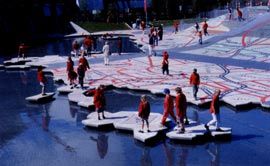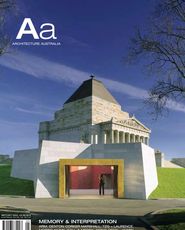

Photography John Gollings


Photography Chris Elliott
THE PANEL THAT conducted the Review of the Exhibitions and Public Programs of the National Museum, chaired by Dr John Carroll, chose to include in its scope the Garden of Australian Dreams (GOAD), while dismissing the building housing the museum’s activities as “ancillary” to the National Museum. The comments on the building focussed on functional issues such as its acoustics rather than questioning its design. In contrast, the panel considered the GOAD to be part of the permanent collection and saw an opportunity to strengthen the garden’s role by enhancing the museum’s coverage of the geological and biological prehistory of the continent of Australia through a makeover of the space.
The conclusions of the review in relation to the GOAD are relatively innocuous: the garden space could be made both inviting and educational; the museum should extend the themes of tangled destinies into the garden; cross-disciplinary advice will be needed to realize the potential of the space. By themselves, these bland and somewhat reserved recommendations would have caused little comment or concern. However, the panel chose to also provide a “conceptual suggestion” for the GOAD – one of several such statements that illuminate the report to illustrate the panel’s view of a future that it sees as positioning the museum on the “world stage”. The limited ambition of the panel’s concepts offered for the GOAD reveal a complete mismatch between the qualities of the space as it exists and the image of a garden as held by the panel. Proposed features to be accommodated include “large rocks that trace the history of the continent”, “vegetation typical of Australia’s past and present”, a sundial, lawn, and more lawn. Two further suggestions are to lower or remove the mound in the centre of the space and to include “well produced representations of Aboriginal rock art” in the expectation that these might “modify the alienating effect of braille embellishments on the building’s surfaces”. Taken together, these comments suggest that the panel was seeking a conventional garden charged with the didactic role of illustrating the prehistory of the Australian landscape. The panel does not directly comment on the existing design of the space – criticism is made by inference and omission – yet the “conceptual suggestions” would completely subvert the critical perceptions and ideas underpinning the design of the GOAD.
The limited images, elements and features drawn upon by the panel members reveal their inadequacy as designers, which is unsurprising as their skills include corporate governance, palaeontology, sociology and anthropology but not design. More surprising is that the panel chose not to consult the designers of the space, Richard Weller and Thomas Sitta of Room 4.1.3, or to seek evaluations of the GOAD from independent and authoritative assessors of landscape design. In addition, it is likely that there were few comments about the GOAD in the submissions to the review, as the published terms of reference were unambiguous in asking for an examination of the museum’s exhibitions. It is unlikely that many would have thought of the GOAD as an exhibition although it is undoubtedly exhibitionary. The wilfulness of the Review Panel in allowing taste rather than expert analysis to guide their evaluation of the GOAD undermines the authority of the overall report and suggests that, at the very least, the “conceptual” suggestions made by the panel should be set aside until they can be thoroughly evaluated and developed with the assistance of expert design advice.
Is the GOAD an exhibition? It certainly did not arise from the museum’s curatorial agenda, rather it developed as thematic landscape for the design of the courtyard caught in the loop of the museum building’s plan. The conceptual design for the GOAD was an exciting and challenging ingredient of the competition scheme for the Acton Peninsula project. It encapsulated ideas and interpretations of the land – its shaping, marking and occupation were deliberately fragmented and collaged into rich intersections of pattern and gesture to draw out themes from the design of the building, from the structure of the collection, and from the museum’s setting within Canberra. The qualities of the GOAD challenge the bucolic remnant and remediated landscapes of the remainder of the Acton Peninsular and offer a critique of the all-embracing landscape order of Canberra itself with its Brownian underlay and gestural acknowledgement of the native bush beyond.
The GOAD is urban not Arcadian, enclosed rather than limitless, complex and challenging rather than simplistic and sedate. The GOAD is more an active event than a space of repose. It reveals clues as to the structure and nature of the forces that seek to control and shape the land and its pre- and postcolonial occupation. Designed to be seen as a whole from the terrace above, it may be experienced and explored as part of the sequence through and around the spaces and exhibits of the museum.
The bounded garden-scape of words, lines, forms and symbolic flora of the GOAD invites exploration of its literal messages, allegorical references and wry metaphors. It may be directly experienced in terms of its exuberant contrivance of surface, sculptural form and colour or its juxtapositions of inscription and patterns may provoke analysis, speculation and enquiry. Like any garden, it is a mirror and foil to the world beyond and, in this case, to the tangle of ideas and actions that concern and affect the discovery, occupation, making and remaking of place in Australia. There are weaknesses and there is much that could be done to complete and enhance the design, which was compromised, to some extent, by changes to meet budget as the construction of the museum approached completion. Such works should properly involve the designers, Richard Weller and Vladimir Sitta, and could have been a fitting recommendation of the review rather than implying that this challenging and internationally recognized design should be supplanted by the emaciated design vision of the panel.
In his book Eccentric Spaces Robert Harrison commences his review of garden spaces by reminding us that, “Every Garden is a replica, a representation, an attempt to recapture something, but the form it finds is that of a mental picture, so in spite of its special properties a garden is just another of the images of art”.1 In this sense, the GOAD forms part of the museum’s collection but more as art than as exhibit. The idea behind its making deserves to be understood and enhanced rather than being uprooted and overturned, which is one possible consequence of the findings of the review. Although the moral rights dimension of the Copyright Act have yet to be tested, the recommendations of the panel and the lack of reference to the designers of the space suggest a disregard for the value and nature of landscape design and so deserve to be challenged by the design professions. The Council of the National Museum should be asked to set aside the recommendations affecting the GOAD until its designers have been consulted. If concerns with the nature of the GOAD remain, then a design review by prominent and authoritative landscape architects should be initiated with one possible outcome being the completion of the design of the GOAD under the direction of Room 4.3.1.
What should be done to prevent another debacle such as that resulting in the emasculation of the Federation Square shard which was reduced from an incisive blade to a mere stump? The design professions should support the response of the President of the Australian Institute of Landscape Architecture, and the targeted challenges to the review recommendations from the designers of the GOAD.We must lobby the Council of the National Museum to amplify the understanding and appreciation of the nature of design and to assert the rights of the designers of this space which is of national significance. Ultimately, there may be good reason why the design of the space should be changed but this should be driven by a thorough review that includes an understanding of the design idea and that embraces a process of consultative review by authoritative and informed design professionals.
Without this understanding of the nature and value of design then the Council of the National Museum may as well accept the Richard Weller’s exasperated suggestion that the “Backyard Blitz” team be invite to work over the Garden of Australian Dreams to better embody the vision of the Review Panel.
PROFESSOR MICHAEL KENIGER IS THE QUEENSLAND GOVERNMENT ARCHITECT AND EXECUTIVE DEAN, FACULTY OF ENGINEERING, PHYSICAL SCIENCES AND ARCHITECTURE, UNIVERSITY OF QUEENSLAND.















